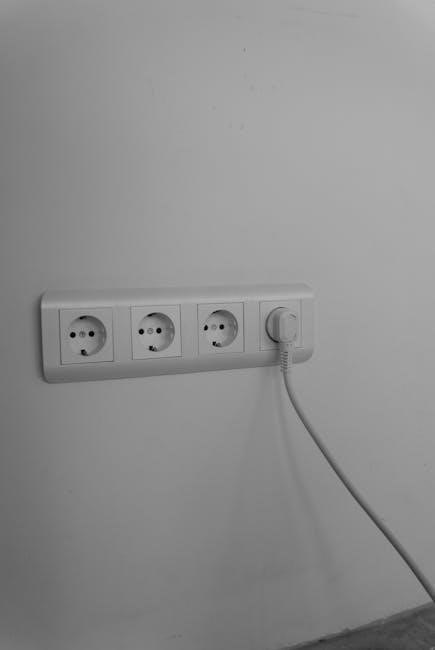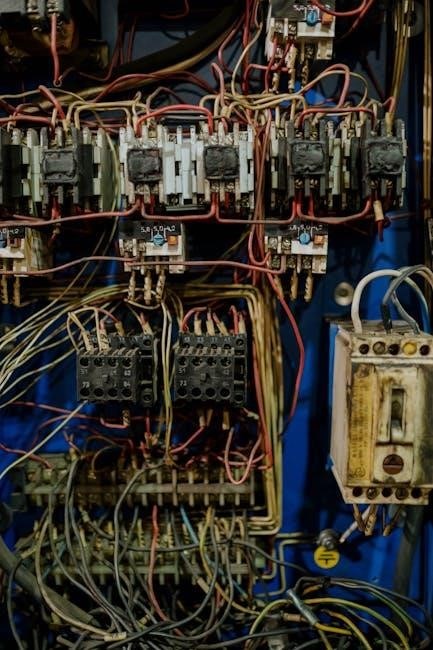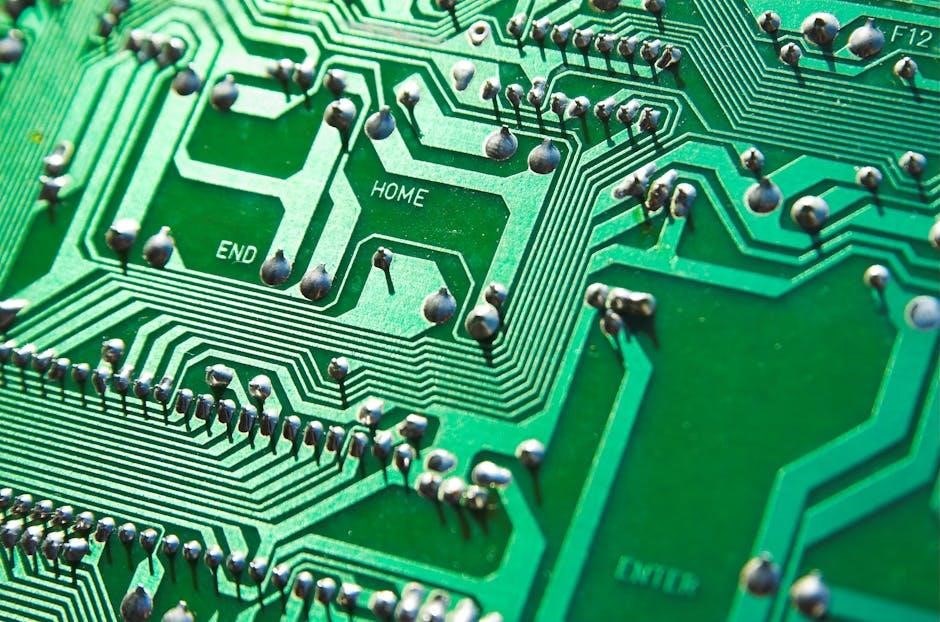A home electrical wiring diagram is a visual representation of a residential electrical system, showing connections and circuits. It guides installations, repairs, and troubleshooting, ensuring safety and compliance with electrical codes. Available as PDFs, these diagrams provide detailed layouts for service panels, circuit breakers, and wiring routes, essential for homeowners and electricians alike.
1.1 What is a Home Electrical Wiring Diagram?
A home electrical wiring diagram is a detailed visual representation of a residential electrical system. It illustrates the connections between various electrical components, such as circuit breakers, outlets, and lighting fixtures. This diagram serves as a blueprint for understanding how power is distributed throughout a house. It typically includes symbols for wires, switches, and devices, making it easier to identify and troubleshoot circuits. Available in PDF formats, these diagrams are essential for electricians and DIY enthusiasts to plan, install, and maintain electrical systems safely and efficiently. They ensure compliance with electrical codes and standards, providing a clear guide for both new installations and existing system modifications.
1.2 Importance of Wiring Diagrams in Home Electrical Systems
Wiring diagrams are crucial for ensuring the safe and efficient operation of home electrical systems. They provide a clear visual guide for installing, maintaining, and troubleshooting circuits, reducing the risk of electrical hazards. By following a wiring diagram, homeowners and electricians can identify potential issues before they escalate, preventing fires and shocks. These diagrams also simplify compliance with local electrical codes and standards, ensuring that all work meets safety regulations. Additionally, they serve as a valuable reference for future modifications or repairs, saving time and reducing costs. Overall, wiring diagrams are essential for maintaining the integrity and reliability of a home’s electrical infrastructure.

1.3 Brief History and Evolution of Wiring Diagrams
Wiring diagrams have evolved significantly since the late 19th century, when electrical systems first became common in homes. Early diagrams were simple sketches, often hand-drawn, to guide installations. As electrical systems grew more complex, standardized diagrams emerged, detailing circuits and connections. By the mid-20th century, wiring diagrams became essential for safety and compliance, reflecting advancements in materials and technologies. The advent of digital tools in the 21st century revolutionized their creation, enabling precise, scalable, and shareable formats like PDFs. Today, wiring diagrams are indispensable for installations, troubleshooting, and ensuring compliance with electrical codes, making them a cornerstone of modern electrical systems.

Types of Home Electrical Wiring Diagrams
Home electrical wiring diagrams include schematic, pictorial, block, and one-line diagrams. Each type provides detailed visual representations of circuits, connections, and components, aiding in installations and troubleshooting.
2.1 Schematic Diagrams
Schematic diagrams are detailed visual representations of electrical circuits, showing components like wires, switches, and outlets. They use symbols to illustrate how systems connect, aiding in installations and repairs. These diagrams are essential for understanding circuit layouts and troubleshooting issues. Available in PDF formats, they provide clear, standardized representations of electrical systems, making them invaluable for both professionals and DIY enthusiasts. Schematic diagrams focus on functionality, simplifying complex systems into understandable visuals. They are a cornerstone of home electrical wiring, ensuring safety and efficiency in all applications.
2.2 Pictorial Diagrams
Pictorial diagrams use images and symbols to represent electrical components, offering a visual layout of a system. They are ideal for understanding physical connections and troubleshooting. These diagrams are user-friendly, making complex systems accessible to visual learners. Pictorial diagrams are widely used in home electrical wiring, providing a clear overview of circuit setups. They are often included in PDF guides, allowing homeowners and electricians to plan and execute installations effectively. By focusing on the physical appearance of components, pictorial diagrams simplify the identification of wiring routes and device locations, enhancing safety and efficiency in electrical work.
2.3 Block Diagrams
Block diagrams simplify complex electrical systems by representing components as blocks connected by lines. They illustrate the functional relationships between devices, making it easier to understand system interactions. These diagrams are less detailed than schematic or pictorial diagrams but are highly effective for planning and troubleshooting. Block diagrams are often included in home electrical wiring PDF guides, providing a clear overview of how power flows through circuits. They are particularly useful for identifying the hierarchy of electrical systems and how components interact. By focusing on functionality rather than physical appearance, block diagrams offer a straightforward approach to understanding and designing home electrical layouts.
2.4 One-Line Diagrams
A one-line diagram is a simplified representation of an electrical system, showing the distribution of power from the service panel to individual circuits. It uses single lines to depict conductors and focuses on the sequence of electrical connections. This diagram is essential for understanding how power flows through a home’s electrical system. One-line diagrams are often included in home electrical wiring PDF guides, providing a clear and concise overview of the system’s structure. They are particularly useful for identifying the main components, such as circuit breakers, and how they are interconnected. This type of diagram is invaluable for planning installations, troubleshooting issues, and ensuring that the electrical system operates safely and efficiently.
Tools and Software for Creating Wiring Diagrams
Software like EdrawMax Online and mobile apps provide tools to create and edit home electrical wiring diagrams. These platforms offer templates and symbols for precise diagram design, ensuring accuracy and compliance with electrical standards.
3.1 Overview of Software Tools
Software tools like EdrawMax Online offer comprehensive solutions for creating home electrical wiring diagrams. These programs provide pre-designed templates, symbols, and libraries to streamline the design process. They allow users to create detailed diagrams, edit existing ones, and share them easily. Many tools support PDF exports, making it convenient to print or distribute diagrams. These software solutions cater to both professionals and DIY enthusiasts, ensuring accuracy and compliance with electrical standards. They often include features like automatic routing, error checking, and customization options, making them indispensable for planning and executing electrical projects efficiently.
3.2 Mobile Apps for Wiring Diagrams
Mobile apps like EdrawMax Online and others provide portable solutions for creating and editing home electrical wiring diagrams. These apps offer intuitive interfaces, allowing users to design circuits, edit diagrams, and export them as PDFs. They are ideal for on-site electrical work, enabling professionals and DIYers to access and modify diagrams directly from their smartphones or tablets. Many apps include libraries of electrical symbols, automatic routing features, and collaboration tools for real-time sharing. They support both iOS and Android platforms, making them accessible for a wide range of users. These apps are essential for streamlining electrical projects, ensuring accuracy and efficiency wherever you go.
3.3 Online Platforms for Diagram Creation
Online platforms like EdrawMax Online offer robust tools for creating and customizing home electrical wiring diagrams. These platforms provide user-friendly interfaces, extensive libraries of electrical symbols, and templates to streamline the design process. They support real-time collaboration, allowing multiple users to work on the same diagram simultaneously. Many platforms enable direct export to PDF format, making it easy to share and print diagrams. Additionally, they often include automatic routing and error-checking features to ensure accuracy. These platforms are accessible via web browsers, eliminating the need for software downloads. They are ideal for both professionals and DIY enthusiasts, offering a flexible and efficient way to create and manage electrical wiring diagrams for residential projects.

Safety Precautions When Using Wiring Diagrams
Always de-energize circuits before working and use personal protective equipment. Understand the diagram thoroughly to avoid errors. Adhere to local electrical codes and safety standards strictly.

4.1 Essential Safety Precautions
When working with home electrical wiring diagrams, always de-energize circuits before starting. Use personal protective equipment like insulated gloves and safety glasses. Ensure the power is off at the service panel or breaker box. Verify voltage absence with a multimeter to prevent shocks or electrocution. Follow local electrical codes and manufacturer instructions. Never attempt repairs without proper knowledge or tools. Keep diagrams accessible for reference during work. Ensure good lighting in the workspace to avoid accidents. If unsure, consult a licensed electrician. Safety should always be the top priority to prevent injuries and property damage.
4.2 Personal Protective Equipment (PPE)
Personal Protective Equipment (PPE) is crucial when working with home electrical wiring diagrams to minimize risks. Essential items include insulated gloves, safety glasses, and a non-contact voltage tester to detect live wires. Arc-rated clothing and a face shield provide protection against electrical arcs. Steel-toe boots and hard hats are recommended for physical protection. Ensure all PPE meets industry standards like ASTM or NFPA. Regularly inspect equipment for damage or wear. Proper PPE use minimizes electrical shock, arc flash, and physical injury risks, ensuring a safer working environment. Always prioritize PPE to protect yourself while handling electrical systems.

4.3 Emergency Procedures

In case of an electrical emergency, such as a short circuit or fire, switch off the main power supply immediately using the service panel. Evacuate the area and call emergency services if the situation is severe. Never use water to extinguish electrical fires; instead, use a fire extinguisher rated for electrical fires (Class C). Keep emergency contact numbers handy, such as the local fire department and electrician. If someone is shocked, do not touch them directly—use an insulated object to break the connection. Stay calm and follow safety protocols outlined in your home electrical wiring diagram. Regularly review these procedures to ensure preparedness and safety.

Common Home Electrical Circuits
Home electrical circuits include lighting, power outlets, and appliance circuits. Lighting circuits power fixtures, while outlet circuits provide plug-in points. Dedicated circuits serve heavy appliances, ensuring safe operation.
5.1 Lighting Circuits
Lighting circuits are essential components of home electrical systems, powering fixtures like ceiling lights, wall sconces, and outdoor lighting. These circuits are typically low-voltage and designed for safety. A lighting circuit usually starts at the service panel, where a circuit breaker or fuse protects the wiring. From there, power is distributed to individual fixtures or groups of lights. Wiring diagrams for lighting circuits often include details like wire colors, connections, and switch configurations. Proper installation ensures energy efficiency and prevents hazards. Understanding these circuits is crucial for troubleshooting issues like flickering lights or power outages. Always refer to a wiring diagram for specific configurations and safety guidelines when working on lighting systems.
5.2 Power Outlet Circuits
Power outlet circuits are a fundamental part of home electrical systems, providing power to receptacles used for appliances and devices. These circuits typically operate at 120 volts and are designed to handle varying loads. They originate from the service panel, where a circuit breaker or fuse protects the wiring. Each outlet is connected in a series or parallel configuration, ensuring reliable power distribution. Wiring diagrams for power outlet circuits detail wire colors, connections, and outlet placements. Ground Fault Circuit Interrupter (GFCI) outlets are often included in areas like kitchens and bathrooms for added safety. Proper installation and maintenance of these circuits are crucial to prevent overloading and ensure safe operation. Always consult a wiring diagram for specific configurations and troubleshooting guidance.
5.3 Appliance Circuits
Appliance circuits are specialized wiring systems designed to power high-voltage devices such as electric ovens, dryers, and air conditioning units. These circuits typically operate at 240 volts and require dedicated 20- to 50-amp breakers. Wiring diagrams for appliance circuits detail the specific gauge of wire needed, connections to the service panel, and proper grounding. They often include GFCI protection in areas like laundry rooms or outdoor spaces. Correct installation ensures safe and efficient operation of heavy-duty appliances. Always refer to a wiring diagram to identify the correct circuit requirements and connections for your specific appliance, as improper wiring can lead to hazards or equipment damage. Consulting a licensed electrician is recommended for complex installations.
Troubleshooting Home Electrical Issues
Troubleshooting home electrical issues involves identifying faults in circuits or connections. Common problems include flickering lights, tripped breakers, or outlets without power. Wiring diagrams help locate issues quickly, ensuring repairs are done safely and efficiently. Always switch off power before inspecting and use tools like multimeters to test circuits. If unsure, consult a licensed electrician to avoid hazards.
6.1 Common Electrical Issues
Home electrical systems often face issues like flickering lights, tripped circuit breakers, or outlets without power. These problems can stem from overloaded circuits, loose connections, or faulty wiring. Other common issues include blown fuses, warm outlets, or buzzing sounds from electrical components. Identifying these problems early is crucial to prevent hazards like fires or electrical shocks. Wiring diagrams are essential for diagnosing these issues, as they provide a clear map of the electrical system. By referencing these diagrams, homeowners or electricians can trace circuits and pinpoint faults efficiently. Regular inspections and maintenance can help mitigate these common electrical issues, ensuring a safe and reliable home electrical system.
6.2 Tools for Troubleshooting
Essential tools for troubleshooting home electrical issues include multimeters, circuit testers, and wire strippers. A multimeter measures voltage, current, and resistance, helping identify faults in circuits. Circuit testers detect live wires and short circuits, ensuring safe inspections. Pliers and screwdrivers are handy for accessing wiring components. Thermal imaging cameras can spot overheating areas in electrical systems. These tools, combined with a wiring diagram, allow for precise fault location and resolution. Regular use of these tools ensures electrical systems operate safely and efficiently, preventing potential hazards. Always refer to the wiring diagram to understand circuit layouts before using these tools for troubleshooting.
6.3 Step-by-Step Troubleshooting Guide
A step-by-step troubleshooting guide helps resolve electrical issues systematically. Start by identifying symptoms, such as flickering lights or tripped breakers. Consult the wiring diagram to locate the affected circuit. Switch off power to the circuit at the service panel. Use a multimeter to test for voltage, continuity, and resistance. Inspect wires and connections for damage or corrosion. Replace faulty components like blown fuses or defective outlets. Turn the power back on and verify if the issue is resolved. Document findings and refer to the wiring diagram for further guidance. Always prioritize safety and follow proper procedures to avoid hazards. This method ensures efficient and accurate troubleshooting of home electrical systems.
Best Practices for Wiring Diagrams
Ensure clear labeling, consistent color coding, and regular updates. Use standardized symbols and organize diagrams logically. Refer to PDF guides for accuracy and safety compliance in home electrical systems.

7.1 Labeling and Organization
Proper labeling and organization are crucial for understanding home electrical wiring diagrams. Clearly label wires, circuits, and components to avoid confusion. Use color coding to differentiate live, neutral, and ground wires. Organize diagrams hierarchically, starting from the service panel to individual circuits. Include legends or keys to explain symbols and abbreviations. Ensure consistency across all diagrams for easy reference. Regularly update labels to reflect system changes. Refer to PDF guides for standardized labeling practices. Well-organized diagrams enhance safety, simplify troubleshooting, and ensure compliance with electrical codes. They also help homeowners and electricians identify components quickly, reducing errors during installations or repairs.
7.2 Color Coding Standards
Color coding is essential for identifying wire functions in home electrical wiring diagrams. Standard colors include black, red, or blue for “hot” wires, white for neutral, and green or bare copper for ground. These colors ensure safety and clarity, reducing the risk of electrical shocks or fires. Consistent color coding helps electricians and homeowners quickly identify circuits and components. Always adhere to local electrical codes and standards for color assignments. Refer to PDF guides for detailed color coding charts and compliance. Proper color coding enhances readability of wiring diagrams, making installations, repairs, and troubleshooting more efficient. It also minimizes errors and ensures a safer electrical system overall.
7.3 Regular Updates and Maintenance
Regular updates and maintenance of home electrical wiring diagrams are crucial for safety and functionality. Over time, electrical systems may be modified or upgraded, requiring revisions to the wiring diagram. PDF guides often include sections on updating diagrams to reflect changes, ensuring accuracy. Routine checks for wear and tear, outdated components, or new installations should be documented. Updating diagrams helps prevent errors during repairs or future modifications. Maintenance also involves ensuring compliance with current electrical codes and standards. Referencing PDF manuals provides guidance on best practices for updating and maintaining wiring diagrams, ensuring they remain reliable and up-to-date. Regular maintenance enhances safety and extends the lifespan of the electrical system.
Resources for Learning and Reference
PDF guides, online courses, and electrical wiring communities provide comprehensive resources for learning and referencing home electrical wiring diagrams. These tools offer detailed instructions and visual aids.
8.1 PDF Guides and Manuals
PDF guides and manuals are essential resources for understanding home electrical wiring diagrams. These documents provide detailed, downloadable instructions and diagrams for various electrical systems. They often include step-by-step guides for installations, repairs, and troubleshooting. Many PDF manuals are available online, such as the House Wiring Diagram PDF Manual Book, which covers residential electrical connections and safety standards. These resources are ideal for homeowners, DIY enthusiasts, and professionals seeking clear, visual representations of wiring layouts. They also offer tips for maximizing system performance and ensuring compliance with local electrical codes. Accessing these PDFs through official websites or platforms like EdrawMax ensures reliability and accuracy.
8.2 Online Courses and Tutorials
Online courses and tutorials are excellent resources for mastering home electrical wiring diagrams. Platforms like Udemy, Coursera, and specialized electrical training websites offer comprehensive courses. These programs provide step-by-step instructions, video demonstrations, and interactive exercises to help learners understand wiring layouts and safety protocols. For example, the Basic Electrical House Wiring Course covers fundamentals such as circuit design and troubleshooting. Many courses include downloadable PDF materials, such as wiring diagrams and manuals, to supplement learning. These resources are ideal for DIY enthusiasts, students, and professionals seeking to enhance their skills. By combining theoretical knowledge with practical applications, online courses ensure a thorough understanding of home electrical systems and their diagrams.
8.3 Electrical Wiring Communities
Electrical wiring communities are invaluable for sharing knowledge and resources on home electrical wiring diagrams. Online forums, social media groups, and specialized websites bring together professionals and DIY enthusiasts. These platforms offer discussions, troubleshooting tips, and access to downloadable PDF guides. For instance, communities like Electrical Wiring Communities provide detailed diagrams and step-by-step instructions. Members often share personal experiences, ensuring practical solutions for common issues. Such communities foster collaboration, helping users stay updated on the latest techniques and safety standards. They are particularly useful for those seeking peer-reviewed advice or looking to refine their skills in interpreting and applying wiring diagrams effectively.

Legal and Compliance Considerations
Adherence to electrical codes, permits, and inspections is crucial for legal compliance. Wiring diagrams must align with local regulations to ensure safety and avoid legal repercussions.
9.1 Electrical Codes and Standards
Electrical codes and standards are essential for ensuring the safety and legality of home wiring systems. These codes, such as the National Electric Code (NEC), provide guidelines for installing and maintaining electrical systems. Compliance with these standards is mandatory to prevent hazards and legal issues. Wiring diagrams must align with local regulations, detailing circuit breakers, grounding systems, and wire sizing. Non-compliance can result in fines, system failures, or even dangerous conditions. Adhering to these codes ensures that electrical systems function safely and efficiently, protecting both property and lives. Properly designed wiring diagrams help in meeting these standards, making them a critical tool for electricians and homeowners alike.
9.2 Permits and Inspections
Obtaining permits and undergoing inspections are crucial steps in ensuring that home electrical wiring meets safety and legal requirements. Permits are typically required for any significant electrical work, such as installing new circuits or upgrading a service panel. Licensed electricians usually handle the permit process, as they are responsible for ensuring compliance with local codes. Inspections are conducted by local authorities to verify that the wiring adheres to safety standards and regulations. Failure to obtain permits or pass inspections can result in fines, disapproval of the work, or even mandatory corrections. Wiring diagrams often play a key role in the inspection process, as they provide a clear visual representation of the system for authorities to review.
9.3 Compliance with Local Regulations
Compliance with local electrical regulations is essential to ensure safety and avoid legal issues. Home electrical wiring diagrams must align with regional codes, such as the National Electrical Code (NEC) in the U.S., which outlines specific requirements for wiring installations. These regulations cover aspects like wire sizing, circuit protection, and grounding systems. Local authorities enforce these standards through permits and inspections, as non-compliance can lead to fines or system disapproval. Wiring diagrams serve as critical documentation, providing a clear reference for inspectors to verify adherence to regulations. Staying informed about local electrical codes and incorporating them into wiring plans is vital for both safety and legal compliance.
